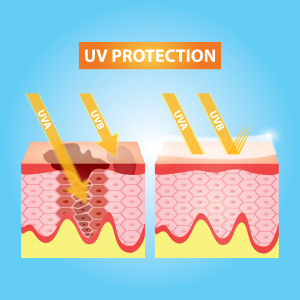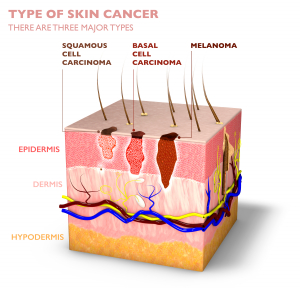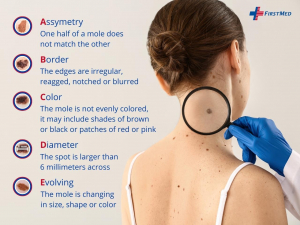The golden hour has many benefits, especially in the summer when bronze skin makes us look much more attractive. We enjoy spending long hours outdoors: lying on the beach, sightseeing in a new city, or hiking in the mountains. While a lot of good comes from the sun and the ultraviolet (UV) radiation it produces, there is the risk of overexposure to sunlight. You might not know that there’s more to sunburn than a simple red patch on your skin. FirstMed’s dermatologists explain how to protect ourselves effectively and avoid adverse skin effects from dangerous UV rays.
How does UV exposure damage skin?

UV rays, invisible to our eyes, are the primary radiation from sunlight. Intense exposure to UV rays emitted by the sun can damage the eyes and cause severe damage to the skin, most notably certain cancers. When you expose yourself to sunlight, the body absorbs UV rays and converts them into energy, which can damage the skin cells.
There are three forms of UV rays:
- UVA (long-wave),
- UVB (mid-wave), and
- UVC (short-wave).
Longer-wavelength UVB rays cause sunburns, while short-wavelength UVC rays can damage the ozone layer, which protects us against the harmful effects of longer-wavelength UVA and UVB rays. UVC rays can also cause severe skin burns and eye irritation, which feels like having sand in the eyes—in extreme cases, you cannot even use your eyes for one to two days.
Knowing a few things about the skin’s structure can help you understand how UV exposure can cause premature skin aging (e.g., wrinkles and age spots) and even skin cancer.
The epidermis has three layers:
- Stratum corneum: an outer layer composed mainly of dead cells that protect your body from germs and bacteria.
- Melanocytes make melanin, which gives skin its color (and a tan in the summer if your skin is genetically receptive).
- Keratinocytes produce proteins such as collagen and elastin, which keep skin looking smooth and firm.
What happens if you spend too much time outside without sunscreen or protective clothing? UV radiation damages these layers over time by penetrating the epidermis and breaking down elastin fibers, making them appear thinner than usual. This may manifest as wrinkles on your face when you smile or laugh!
Avoid sunburn to prevent skin cancer
Stay in the shade between 10 a.m. and 4 p.m. to avoid sun damage when the sunshine is the strongest. If you must go outside during these times, protect yourself against the dangerous rays:
- wear protective clothing,
- use sunglasses, and
- apply sunscreen with an SPF of 30 or higher that specifies protection from UVA and UVB rays (and reapply it frequently, if necessary).
If you get burned, relieve the symptoms by cooling the sunburned area with a cold compress or cold water, followed by a moisturizing lotion containing aloe vera.
While these precautions may seem excessive, they can help reduce your risk of skin damage due to sun exposure.
What are the main types of skin cancer?

UV radiation from frequent, excessive exposure to sunlight increases your risk of developing cancer later in life. The most common types of skin cancer are basal and squamous cell carcinoma. Melanoma is a more severe but less common form of skin cancer, which is also related to sun exposure.
Basal Cell Carcinoma and Squamous Cell Carcinoma
Basal cell carcinomas (BCCs) may look like pink or red growths on your skin, whereas squamous cell carcinomas (SCCs) can appear as red scaly patches or bumps that may bleed easily if scratched or bumped. These non-melanoma skin cancers may grow slowly but can also spread quickly. Don’t leave these untreated; prevent the spreading to deeper layers of your skin or other parts of your body through lymph nodes or blood vessels.
Melanoma
Melanoma is a severe form of skin cancer. It arises when pigment-producing skin cells, the melanocytes, become cancerous. Melanomas have uneven edges and may have scalloped or notched borders, while common moles tend to have smoother, more even edges. A warning sign of a mole is the presence of multiple colors. While benign moles generally appear evenly brown or tan, melanomas often have shades of brown, tan, or black.
Surgical removal or excision is the only treatment when melanomas have already formed. Unfortunately, melanoma is becoming more common every year, especially among those with sunburns during childhood.
When should you have your skin checked?

Early detection is crucial. Check your skin thoroughly every three months, from the top of your head to the soles of your feet. Ask your partner or friend to help check areas you can’t see, like your back, the back of your ears, and your genital area. In addition to self-checks, you should have a full-body skin examination with your dermatologist at least once a year.
Visit a dermatologist if you suspect the early signs of melanoma, like a new mole or one with unique characteristics, such as changes in shape or size, itching, or bleeding. Proper age spots are non-cancerous; however, if you detect a darker mark rapidly changing in size or shape, visit a dermatologist. If you spend a lot of time in the sun, have a family history of skin cancer, or have suspicious moles, you should be screened regularly from age 20.
How is skin cancer diagnosed?
During a skin screening, the doctor will examine your skin and decide whether you need further assessment. Skin biopsy is the only way to know whether you have skin cancer. It is the removal of a tissue sample to collect the cells necessary for the examination, which is then performed by a microscope.
Conclusion
The skin is your body’s largest organ and first line of defense and deserves proper protection! At a minimum, UV light can cause wrinkles, dryness, and other signs of aging, but it can also lead to skin cancer if not treated in time! You should always protect your skin from the sun because it can cause damage that could last for years after your tan fades away. Follow our tips to have a safe and fun summer.
If you have any questions or experience any of the symptoms detailed above, do not hesitate to make an appointment for a dermatologist check. We offer special pricing for skincare treatments on Saturdays.




